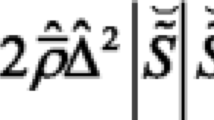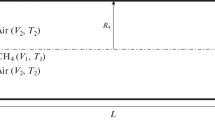Abstract
Two different combustion models, the autoignition (AI) model and flamelet/progress variable (FPV) model, have been applied to study the auto-ignition process of methane/air jet flame in vitiated co-flow. A priori study was conducted to test the validity of the two models. Results show that the different range of predicted reaction rates is mainly responsible for their different performances in large eddy simulation (LES) studies. In this paper, beta PDF was used to model the mixture fraction distribution, while two different shapes of PDF, delta function and beta function, were applied for the reaction progress. Compared to the FPV model, the AI model combined with beta function for reaction progress could capture the auto-ignition process and predict the exact lifted height. Also the results indicate that the variance of reaction progress plays an important role in predicting the flame lifted height.
Similar content being viewed by others
References
Christo F C, Dally B B. Modeling turbulent reacting jets issuing into a hot and diluted coflow. Combust Flame, 2005, 142: 117–129
Ihme M, Yee C S. LES flamelet modeling of a three-stream MILD combustor: analysis of flame sensitivity to scalar inflow conditions. Proc Combust Inst, 2011, 33: 1309–1317
Dally B B, Karpetis A N, Barlow R S. Structure of turbulent non-premixed jet flames in a diluted hot coflow. Proc Combust Inst, 2002, 29: 1147–1154
Cabra R, Chen J Y, Dibble R W, et al. Lifted methane-air jet flames in a vitiated coflow. Combust Flame, 2005, 143: 491–506
Bilger R W, Pope S B, Bray K N C, et al. Paradigms in turbulent combustion research. Proc Combust Inst, 2005, 30: 21–42
Pitsch H. Large-eddy simulation of turbulent combustion. Ann Rev Fluid Mech, 2006, 38: 453–482
Pierce C D, Moin P. Progress-variable approach for large-eddy simulation of non-premixed turbulent combustion. J Fluid Mech, 2004, 504: 73–97
Pitsch H, Steiner H. Large-eddy simulation of a turbulent piloted methane/air diffusion flame (Sandia flame D). Phys Fluids, 2000, 12: 2541–2554
Jha P K, Groth C P T. Tabulated chemistry approaches for laminar flames: Evaluation of flame-prolongation of ILDM and flamelet methods. Combust Theor Model, 2012, 16: 31–57
Verhoeven L M, Ramaekers W J S, Van Oijen J A, et al. Modeling non-premixed laminar co-flow flames using flamelet-generated manifolds. Combust Flame, 2012, 159: 230–241
Mastorakos E. Ignition of turbulent non-premixed flames. Prog Energy Combust Sci, 2009, 35: 57–97
Yoo C S, Sankaran R, Chen J H. Three-dimensional direct numerical simulation of a turbulent lifted hydrogen jet flame in heated coflow flame stabilization and structure. J Fluid Mech, 2009, 640: 453–481
Patwardhan S S, De S, Lakshmisha K N, et al. CMC simulations of lifted turbulent jet flame in a vitiated coflow. Proc Combust Inst, 2009, 32: 1705–1712
Navarro-Martinez S, Rigopoulos S. Large eddy simulation of a turbulent lifted flame using conditional moment closure and rate-controlled constrained equilibrium. Flow Turbul Combust, 2011, 87: 407–423
Cao R R, Pope S B, Masri A R. Turbulent lifted flames in a vitiated coflow investigated using joint PDF calculations. Combust Flame, 2005, 142: 438–453
Gkagkas K, Lindstedt R P. Transported PDF modelling with detailed chemistry of pre- and auto-ignition in CH4/air mixtures. Proc Combust Inst, 2007, 31: 1559–1566
Domingo P, Vervisch L, Veynante D. Large eddy simulation of a lifted methane jet flame in a vitiated coflow. Combust Flame, 2008, 152: 415–432
Michel J B, Colin O, Angelberger C, et al. Using the tabulated diffusion flamelet model ADF-PCM to simulate a lifted methane-air jet flame. Combust Flame, 2009, 156: 1318–1331
Gordon R L, Masri A R, Pope S B, et al. Transport budgets in turbulent lifted flames of methane autoigniting in a vitiated co-flow. Combust Flame, 2007, 151: 495–511
Duwig C, Fuchs L. Large eddy simulation of a H2-N2 lifted flame in a vitiated co-flow. Combust Sci Tech, 2008, 180: 453–480
Ihme M, See Y C. Prediction of auto-ignition in a lifted methane air flame using an unsteady flamelet progress variable model. Combust Flame, 2010, 157: 1850–1862
Peters N. Turbulent Combustion. Cambridge: Cambridge University Press, 2000
Pitsch H. FlameMaster: A C++ computer program for 0D combustion and 1D laminar flame calculations. http://web.stanford.edu/group/pitsch/Home.htm
Galpin J, Angelberger C, Naudin A, et al. Large eddy simulation of H2-air auto-ignition using tabulated detailed chemistry. J Turbul, 2008, 9: 1–21
Bray K, Domingo P, Vervisch L. Role of the progress variable in models for partially premixed turbulent combustion. Combust Flame, 2005, 141: 431–437
Sung C J, Law C K, Chen J Y. An augmented reduced mechanism for methane oxidation with comprehensive global parametric validation. Proc Combust Inst, 1998, 27: 295–304
Wall C, Boersma B J, Moin P. An evaluation of the assumed beta probability density function subgrid-scale model for large eddy simulation of nonpremixed, turbulent combustion with heat release. Phys Fluids, 2000, 12: 2522
Poinsot T, Veynante D. Theoretical and Numerical Combustion. Philadelphia, PA: RT Edwards, Inc., 2005
Pierce C D, Moin P. A dynamic model for subgrid-scale variance and dissipation rate of a conserved scalar. Phys Fluids, 1998, 10: 3041–3044
Ihme M, Pitsch H. Prediction of extinction and reignition in nonpremixed turbulent flames using a flamelet/progress variable model: 2. Application in LES of Sandia flames D and E. Combust Flame, 2008, 155: 90–107
Pope S B. Turbulent Flows. Cambridge: Cambridge University Press, 2000
Smith G P, Golden D M, Frenklach M, et al. GRI-Mech-An optimized detailed chemical reaction mechanism for methane combustion. Technical Report. Gas Research Institute, 1999
Michel J B, Colin O, Veynante D. Comparison of differing formulations of the PCM model by their application to the simulation of an auto-igniting H2/air Jet. Flow Turbul Combust, 2009, 83: 33–60
Author information
Authors and Affiliations
Corresponding author
Rights and permissions
About this article
Cite this article
Han, C., Zhang, P., Ye, T. et al. Numerical study of methane/air jet flame in vitiated co-flow using tabulated detailed chemistry. Sci. China Technol. Sci. 57, 1750–1760 (2014). https://doi.org/10.1007/s11431-014-5604-3
Received:
Accepted:
Published:
Issue Date:
DOI: https://doi.org/10.1007/s11431-014-5604-3




